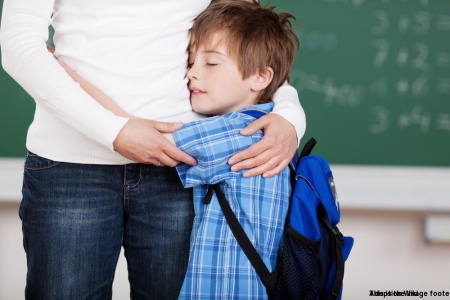Grade School: Understanding Child Development and the Impact of Adoption
This was taken directly from Child Welfare Information Gateway
School-age children—those between the ages of 6 and 12—are learning critical skills and gaining interests that will carry into adolescence and adulthood. Adoption can add layers of complexity to their developmental tasks. Adoptive parents can best support their children by learning as much as they can about child development and by being aware of how adoption may influence their child’s emotional growth.
This information is designed to help you understand and respond to your adopted school-age child’s developmental needs. It provides simple, practical strategies you can use to foster healthy development, including approaches for building attachment, talking honestly with your child about adoption, acknowledging his or her adoptive history, using appropriate discipline, and enhancing your child’s school experience. Because some adoptive families will need extra help addressing their children’s mental health needs, this also discusses when and how to seek help.
School-aged children go through many significant developmental changes. It is important for parents to understand the typical tasks and needs of school-aged children as well as how adoption-related experiences may affect children. Knowing what to expect will help you meet your child’s needs, strengthen your relationship, and identify and address important emotional or physical concerns.
The section below is an overview of growth and development patterns for school-age children; the sections that follow address issues related to adoption, their potential effects on child development and school experiences, and specific ways that you can help your child meet these challenges. It is important to remember that not all of these issues apply to all adopted children; personal histories and experiences vary greatly from child to child.
Contents
Developmental Overview
Developmental changes common to 6- to 12-year-olds include:
- Physical changes. Children in this age group develop rapidly in their physical strength, skills, and coordination. Both the large muscles (legs, arms, and body trunk) and the small muscles of the hands and fingers are developing.
- Ability to process information from the senses (sensory integration). By grade school, most children are able to react appropriately to information they get from their five senses (sight, hearing, taste, smell, and touch).
- Ability to process information from the senses (sensory integration). By grade school, most children are able to react appropriately to information they get from their five senses (sight, hearing, taste, smell, and touch).
- Social and emotional development. School-age children learn to describe and control their feelings. As they mature, their relationships deepen. They discover empathy—the ability to consider others’ feelings and points of view.
- Greater sense of self. In middle childhood, children develop an identity based on who they are in relation to their family, classmates, ethnic group, and community members. This is a major developmental task, particularly in the upper age range of this group.
- Growing independence. School-age children become more independent and increase their activities and social contacts out of the home. Peer relationships become more important as they approach adolescence.
A child’s history and adoptive experience can affect his or her development. When thinking about their child’s progress, parents should consider factors around their child’s adoption, such as its social and emotional impact; developmental delays; and effects of prenatal exposure to alcohol or other drugs, child abuse and neglect, or multiple moves.
Social and Emotional Impact of Adoption
School-age children form a stronger sense of who they are. Much of that identity comes from their family and the relationships with the people in their lives. For adopted children, developing an identity is more complicated. They must merge two separate families and histories as they explore how they fit in. In middle childhood, children adopted as infants or toddlers often start thinking about themselves and their pasts more carefully. They begin to sort through critically important questions about who they are. Those who felt “special” and “chosen” because they were adopted may begin to realize, at least subconsciously, that someone else “unchose” them. Many struggle with issues of self-worth, self-esteem, and being different.Newly adopted children may be grieving for previous homes or caretakers. Some adopted children may have difficulty with social relationships outside the family. These emotional tasks can interfere with concentration and distract children from schoolwork.
Other social and emotional concerns that adoptive parents should be aware of are:
- Children who did not spend enough time with emotionally healthy adults may have difficulty identifying and controlling their emotions.
- Children from orphanages or group care settings may not have had many opportunities to see or practice healthy social interactions.
- Children who were maltreated may not have learned how to empathize with others, may have learned to relate to others in a violent way, or many reenact trauma they have experienced.
- Children who have been separated abruptly from previous caretakers to their primary caregivers (see below) may be anxious when they are away from home.
What you can do:
- Use age-appropriate language, talk with your child about his or her relationships with others.
- Help your child remember the places where he or she has lived and the people who were in his or her life before coming to your home.
- Speak positively about birth family members and prior caretakers.
- Teach your child the words for various feelings.
- Explain to you child how to handle and express emotions.
- Be a positive example to your child as you express emotions. (“I feel so angry right now, I think I’ll take a walk until I cool down.”)
- Teach your child how to interact with others. Practice how to greet a playmate, how to ask for something, how to share.
- Coach your child on how to see things from another person’s point of view. (“I wonder how Sammy felt when no one chose him for their team.”) This helps children develop empathy.
- Make sure there is plenty of family time: routines, schedules, consistence, and a safe and secure environment.
The Importance of Attachment
Attachment refers to the emotional connection that develops between an infant and his/her primary caregiver. This process is very important to all aspects of a child’s later development. Attachment is the basis for trust, and it shapes how a child will relate to the world, learn, and form relationships throughout life.
Healthy attachment occurs when the infant experiences a primary caregiver as consistently providing emotional essentials such as touch, movement, eye contact, and smiles, in addition to the basic necessities such as food, shelter, and clothing. A healthy primary attachment teaches young children that their needs will be met. This attachment frees them to explore, play, learn, and develop relationships.
If the attachment process is disrupted, the child may not develop the secure base necessary to support future healthy development. Factors which may impair healthy attachment include: spending early years in orphanages or large group homes, multiple moves from caregiver to caregiver, invasive or painful medical procedures, sudden or traumatic separation from the mother, hospitalization at critical developmental periods, neglect, sexual or physical abuse, prenatal alcohol or drug exposure, and neurological problems.
A child with insecure attachment might show traits of young child in the “oral stage,” with abnormal speech patterns and eating patterns. Children with insecure attachments may show developmental delays (see next section); however once these children are placed permanently in a family where there are stable parents and no substance abuse, they often make great strides.
If your child had inconsistent care in his or her early years, you can parent in ways that repair and develop healthy attachments. Think about the age of your child at the time he or she experienced trauma (such as being moved from one caregiver to another). In some ways, your child may be “stuck” at this stage of development. When you interact with your child according to his or her emotional and physical needs, you improve attachment. A skilled adoption counselor or professional can help you and your child strengthen your attachment to each other.
A word of caution: Avoid “attachment therapies” that use questionable techniques such as physically restraining, isolating, or placing children in residential care away from their families. Attachment runs along a continuum; most children with insecure attachments do not have the most severe form of attachment disorder, called Reactive Attachment Disorder. Beware of therapists who are quick to use that terminology or diagnosis
What you can do:
- Give your child the amount and type of structure, nurturing, attention, and supervision you could normally give a child several years younger.
- Establish consistent one-to-one parent/child time.
- Talk to and play with your child every day, even if only for a few minutes.
- Make eye contact and smile before you address your child.
- Offer gentle words of encouragement and praise often.
- Use “time in” rather than “time out” with children who have attachment issues.
- Find age-approprate ways to have physical contact (hugs, combing hair, kneading dough together).
- Place notes with kind messages in lunch boxes and leave small surprises for after school.
- Engage your child in planning future events.
- Speak positively about birth parents and other caregivers from the child’s past.
- Fuss over your child at every opportunity.
- Nurture, nurture, nurture!
Developmental Delays
Some adopted children may have developmental delays. A developmental delay is defined as a significant lag in one or more skill areas. Delays can be caused by genetic factors (such as Down syndrome) or environmental factors (including exposure to alcohol or other drugs during pregnancy, trauma, neglect, or insecure attachment). In some cases it is difficult to know what caused a developmental delay.
Children learn skills and develop at different rates, so don’t worry if your child is slightly behind peers in one or two areas. Also, learning a second language or adjusting to a new culture may create temporary delays. While many children will catch up developmentally, others will not.
What you can do:
- Ask your school or doctor for a professional assessment if you notice:
- Significant lags in many developmental areas
- Loss of previous skills
- Extreme behavior
- Signs of sensory difficulties, such as extreme reactions to touch, light, sounds, or motion
- Access screening and other resources through Medicaid’s Early and Periodic Screening, Diagnostic, and Treatment (EPSDT) service, if they are available to your family: here.
- If an assessment reveals that your child has a disability:
- Focus on building and maintaining a strong foundation of attachment with your child (see previous section). Children with insecure attachment to primary caregivers may be cognitively younger than their actual age.
- Advocate for school personnel to work with you to develop an Individualized Educational Plan (IEP) that will ensure special education services to address your child’s needs.
- Learn about your child’s condition. For a list of organizations that provide information about children with special needs, see here
- Join a support group, in person or online, for adoptive parents or other parents of children who have your child’s specific disability.
- Inform your child’s teacher about his or her condition. Provide specific information about how the delay or disability affects your child’s ability to succeed in school. Ask the teacher to:
- Give your child more time to complete tasks
- Assign worksheets or tests with fewer problems per page.
- Provide him or her with extra classroom space or a quiet location to improve concentration.
- Make sure your child’s teacher is sensitive/informed about adoption issues.
- Create a less distracting environment for homework. Provide homework assistance or tutoring if needed.
- There are many resources to help teachers and parents explore additional strategies.For more information, see the Resources for teacher section of the Information Gateway website
Effects of Child Maltreatment and Trauma
Exposure to child maltreatment and trauma affect how children learn, think, feel, and interact, even after they join safe and stable adoptive homes. For example, maltreated children:
- May exhibit speech or other developmental delays
- May have experienced chaotic home conditions that lacked consistent schedules, consequences, and expectations
- May not have witnessed healthy relationships, had appropriate role models, or learned how to communicate with others
- May have not developed appropriate social skills or personal hygiene habits, due to a lack of consistent and appropriate parent-child interaction
- May not have attended school consistently, learned study habits, or had a stable home life that supported learning
In addition, children who were sexually abused may have sexual feelings, knowledge, and questions not common to children of the same age. They may need loving guidance and redirection to learn how to deal with those memories and feelings in a socially acceptable manner. For more information, see Parenting a Child Who Has Been Sexually Abused: A Guide for Foster and Adoptive Parents on the InformationGateway website.
What you can do:
- Interact with your child according to his or her developmental needs instead of the child’s chronological age.
- Teach your child acceptable patterns of interaction and communication for his or her age. Use simple explanations, examples, and practices.
- Give your child clear information about sexuality and sexual development.
- Teach your child about safety, privacy, and appropriate ways of showing affection.
Base Interactions on Developmental Needs, Not Age
If your child came from an institution or an abusive family situation, he or she may have missed out on some important tasks, such as learning to communicate with others and express feelings appropriately. Playing with other children, taking turns, or just having fun may be new experiences. As a result, your child may need time to catch up to children in the same age group in some skills. If English is not the child’s first language, he or she may have added delays and challenges.
If your child came from an institution or an abusive family situation, he or she may have missed out on some important tasks, such as learning to communicate with others and express feelings appropriately. Playing with other children, taking turns, or just having fun may be new experiences. As a result, your child may need time to catch up to children in the same age group in some skills. If English is not the child’s first language, he or she may have added delays and challenges.
Continue to Grade School: Communicating about Adoption or return to Adoption Parenting
Resource
Child Welfare Information Gateway. Available online at www.childwelfare.gov/pubs/factsheets/parent_school_age/ ChildWelfare.gov]


